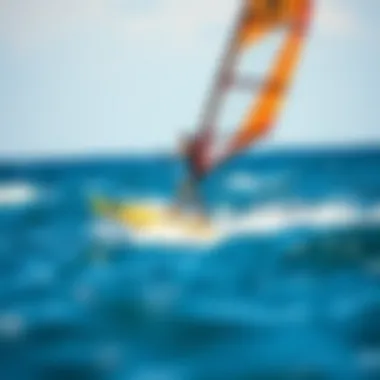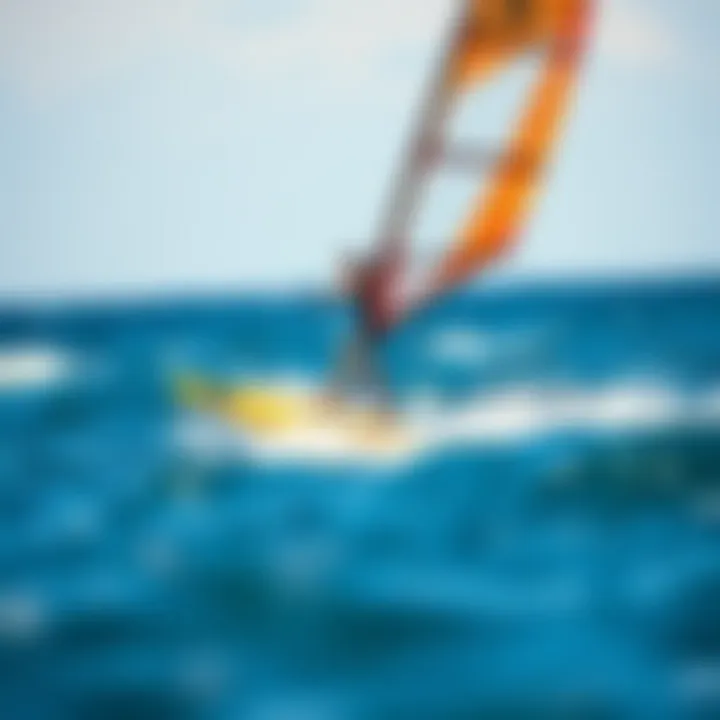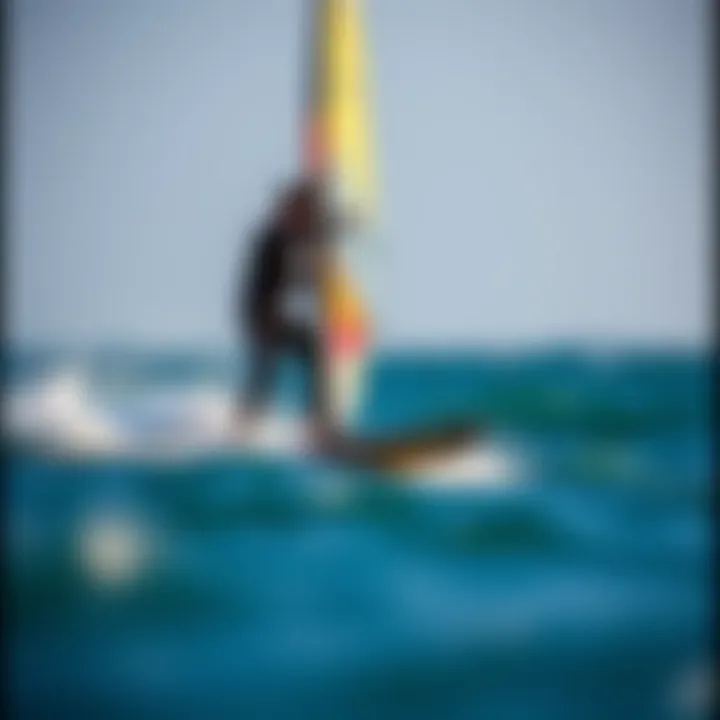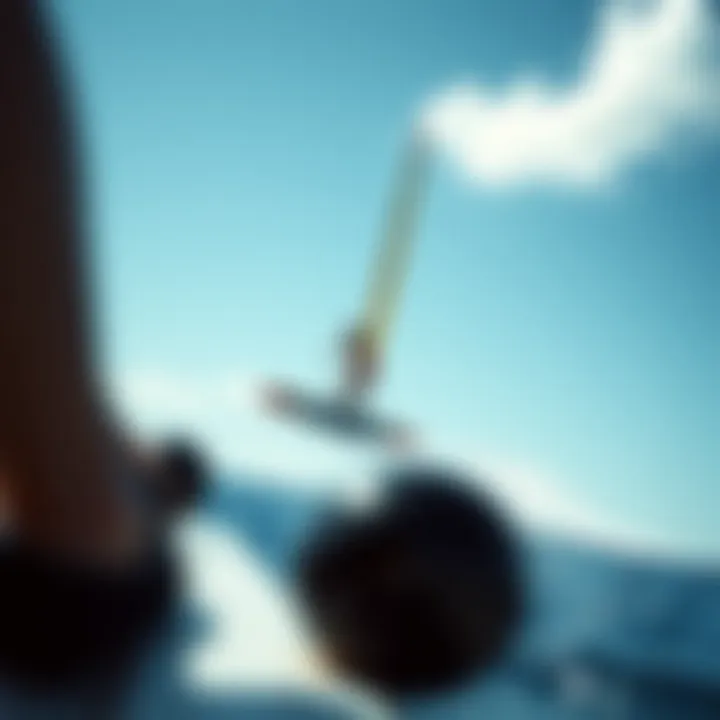Hydrofoil Sailboarding: A Comprehensive Look


Gear and Equipment
Hydrofoil sailboarding, often regarded as a cutting-edge manifestation of water sports, is not just about the thrill of riding atop the waves; it also encompasses a carefully selected array of gear and equipment that elevates the entire experience. To grasp the essence of this sport, one must delve into the latest technologies of surfboards and the essential accessories that accompany them.
Latest Surfboard Technologies
The heart of hydrofoil sailboarding lies in the surfboard itself, which is often equipped with advanced features designed to optimize performance. These boards are typically longer and broader than traditional surfboards, enabling better balance and buoyancy during take-off. The incorporation of hydrofoils—a structure resembling a wing that extends underwater—helps lift the board out of the water at high speeds, decreasing drag and allowing for smoother gliding.
Noteworthy advancements in surfboard technology include flexible materials like carbon fiber, which provides strength without adding weight. Some manufacturers now offer modular boards with customizable foil units, letting riders tailor their setup based on wind and water conditions. The equilibrium between design and functionality is critical, paving the way for breakthroughs that make hydrofoil sailboarding more accessible and enjoyable.
Essential Accessories for Every Surfer
Apart from the surfboard, a slew of accessories can enhance one’s hydrofoil sailboarding adventure. These items not only improve performance but also ensure safety and comfort. Here are some essential picks:
- Safety Gear: A well-fitting personal flotation device (PFD) is crucial. Many surfers opt for buoyancy aids that are streamlined to allow for mobility.
- Wetsuits: Depending on the temperature, a good quality wetsuit made from durable neoprene can provide warmth and protect against abrasions in case of a fall.
- Foot Straps: These straps provide stability during maneuvers and are often adjustable to cater to different foot sizes.
- Helmet: For added protection, especially for beginners and those venturing into uncharted waters, a helmet can safeguard against potential impacts.
- Leashes: A reliable surfboard leash is vital. It prevents the board from drifting away after a wipeout, ensuring easy retrieval and reducing risk to other surfers.
In the swirling chaos of waves and wind, the right gear can make all the difference between a delightful ride and a disastrous tumble. This careful selection does not merely enhance the experience; it can transform the sport into a thrilling pursuit.
"Hydrofoil sailboarding challenges riders to harness the elements while enjoying the unparalleled sensation of flight over water."
As with any sport, knowledge of gear composition, functionality, and suitability directly correlates with an individual’s performance levels, easing the steep learning curve that often accompanies such a dynamic activity.
Surf Techniques and Skills
The beauty of hydrofoil sailboarding is not just in the equipment; it's deeply rooted in the techniques and skills necessary to master this captivating sport. Whether a novice or an ardent enthusiast, refining one's skills can lead to a richer experience. In this section, we will explore foundational techniques for beginners and advanced maneuvers for seasoned sailors.
Beginner Surfing Techniques
For those just dipping their toes into hydrofoil sailboarding, starting with the basics is paramount. Here are a few techniques beginners should focus on:
- Balance Practice: Before hitting the waves, spend some time on land to practice balance on the board, as buoyancy shifts significantly when the foils lift.
- Start-up Technique: On calm water, begin in a kneeling position. As you gain momentum, gradually shift into a standing position, allowing the foil to engage naturally.
- Turning and Leaning: Learning to control the body by leaning forward or backward will help manage speed and direction. Initiate gentle turns by leaning into the direction you wish to go—it's almost like dancing with the water.
- Feet Placement: Understanding where to place your feet can greatly influence control. As a starting point, keep your feet near the mast, adjusting as you gain experience.
Advanced Maneuvers for Experienced Surfers
Once the fundamentals have been mastered, more daring techniques await the seasoned rider:
- Jumping: This involves using the foil's lift to take off briefly from the surface, adding excitement and flair. Timing and confidence play significant roles here.
- Waves Riding: Expert surfers can catch and ride waves while maintaining a smooth foil glide, ensuring a smoother breakout from traditional surfing techniques.
- Backside Turns: Engaging in sharp, quick turns while spinning backwards can amplify the thrill; however, this requires a depth of skill and confidence.
Whether you are just starting or looking to refine your techniques, pushing one’s limits responsibly can lead to rewarding outcomes in hydrofoil sailboarding. The sense of community, shared experiences, and mutual learning nurture a richer environment for all enthusiasts.
Understanding Hydrofoil Technology
In the realm of water sports, hydrofoil technology represents a remarkable leap, blending aerodynamic principles with aquatic dynamics. As we dive into this topic, understanding hydrofoil technology equips enthusiasts and potential practitioners with invaluable insights into what makes hydrofoil sailboarding an exciting venture.
Simply put, hydrofoils allow sailboards to lift above the water’s surface, significantly reducing drag. This enables extraordinary speeds and a unique riding experience unlike traditional methods. The importance of grasping hydrofoil technology lies in its contribution to performance enhancement and adaptation in varied water conditions. While traditional windsurfing is tied to surface resistance, hydrofoil boards glide smoothly, making them suitable for a broader range of environments, from lakes to choppy ocean waves.
Principles of Hydrofoils
Hydrofoils operate on elementary principles of lift and drag. They resemble airplane wings in shape, and when the board moves forward, water flows over the foil, generating lift. This lift raises the board out of the water, providing minimal resistance. To put it plainly, you could say that the hydrofoil acts as a magic carpet, enabling riders to zip over the water with much less effort than traditional methods.
Key principles include:
- Lift Generation: The angle of attack, or the angle at which the foil meets the water, dictates the amount of lift produced.
- Drag Reduction: With the board elevated, friction caused by water is significantly diminished, allowing for faster speeds.
- Control Mechanisms: Riders can adjust their weight and body position to change the angle and thus the performance of the hydrofoil, anchoring stability even in turbulent conditions.
History and Evolution of Hydrofoil Design
The history of hydrofoils traces back to the early 1900s when innovators like Giovanni Battista Caproni experimented with flying boats. Over the decades, this concept morphed, influenced by advances in materials and engineering. By the late 20th century, hydrofoil surfboards began to emerge, tweaking designs to cater to an enthusiastic crowd seeking speed and innovation.
Today, brands like F-One and Naish have revolutionized hydrofoil boards, introducing lighter and more robust materials that enhance performance. The timeline from rudimentary attempts to high-tech designs showcases a commitment to exploration and improvement within the sport.
How Hydrofoils Work
Understanding how hydrofoils work is crucial for anyone looking to embrace hydrofoil sailboarding. Essentially, once a rider gains sufficient speed, the hydrofoil transitions from a submerged state to a plane. At this point, a delicate balance of forces sets in.


- Take-off: To initiate lifting off the water, riders often have to shift their weight towards the tail of the board while maintaining speed.
- In the Air: After lobing off, the foils can be fine-tuned using the rider’s posture. Keeping the center of gravity stable is critical; lean too far forward or backward, and one could risk crashing back into the water.
- Landing: When preparing to touch down, slowing the board gradually reduces risk. Bringing the board back onto the water can be tricking, so finesse and patience are key.
By grasping these fundamentals, aspiring hydrofoil sailboarders can appreciate the remarkable blend of science and thrill that this sport offers. The technology isn’t merely about fun; it exemplifies innovation and our pursuit of pushing boundaries on water.
Hydrofoil Sailboarding Explained
Hydrofoil sailboarding represents a dynamic blend of technology and sport that reshapes how enthusiasts engage with wind and water. Unlike traditional sailboarding, where the rider remains at the mercy of waves and wind, hydrofoil sailboarding elevates the experience—both literally and figuratively. In this section, we will delve into what hydrofoil sailboarding actually entails, highlight the differences it boasts over standard sailboarding, and explore the various types available in the sport. Understanding these facets is crucial for novices and seasoned riders alike, aiming to get the most out of their time on the water.
What Is Hydrofoil Sailboarding?
At its core, hydrofoil sailboarding involves a sailboard fitted with a hydrofoil—a streamlined structure that lifts the board above the water surface as speed increases. This lift effect significantly reduces water drag, allowing the board to glide smoothly. It's a game-changer in the world of water sports, offering riders a whole new realm of fun and performance. Riders can achieve higher speeds, enjoy better maneuverability, and experience fewer bumps from waves, all while feeling a unique sensation of flying above the water.
Key Differences from Traditional Sailboarding
Hydrofoil sailboarding diverges from traditional sailboarding in several pivotal ways:
- Lift vs. Drag: In standard sailboarding, the board rides on the water, leading to increased drag and slower speeds. Hydrofoils create lift, allowing the board to hover atop the surface and enhancing speed.
- Stability and Balance: Hydrofoil boards often demand more skill in terms of balance, as the lift dynamic shifts the center of gravity. A good sense of equilibrium is essential to keep the board steady during maneuvers.
- Skill Development: The learning curve can be steeper compared to traditional methods; while traditional boards allow for more forgiving errors, hydrofoils require precise control and technique.
"Hydrofoil sailboarding gives you the sensation of flying over water, changing how you approach the sport as a whole."
Types of Hydrofoil Sailboards
Hydrofoil sailboards vary greatly, catering to different styles, skill levels, and conditions. Here’s a closer look at some common types:
- Freestyle Hydrofoils: Designed for tricks and acrobatics, these boards prioritize agility and responsiveness, allowing riders to showcase their skills.
- Race Hydrofoils: Built for speed and efficiency, these boards feature longer and narrower foils to achieve high velocities on flat water.
- All-Mountain Hydrofoils: Versatile boards suitable for various conditions, they strike a balance between speed and stability, ideal for riders looking to explore diverse environments.
Deciding which type of hydrofoil sailboard to pursue involves considering personal goals and riding preferences. By understanding each category, riders can select equipment that matches their ambitions on the water, ensuring an exhilarating experience every time.
Advantages of Hydrofoil Sailboarding
The concept of hydrofoil sailboarding stands out for various reasons, each contributing to its allure among sailing enthusiasts. In this section, we will delve into the advantages of this dynamic sport, touching upon specific elements that are pivotal not just for those already enthralled, but also for beginners contemplating their first foray into hydrofoiling. Understanding the benefits can bolster enthusiasts’ enthusiasm and help them make well-informed decisions.
Speed and Efficiency
One of the most talked-about aspects of hydrofoil sailboarding is its impressive speed. When a board is fitted with a hydrofoil, it can lift above the water’s surface, significantly reducing drag. This phenomenon allows riders to reach higher velocities compared to traditional sailboards. A typical rider might find themselves effortlessly skimming across the water at speeds that are both thrilling and exhilarating.
- Physics at Play: As the board rises, it encounters much less water resistance. This means that less energy is needed to maintain speed, which is crucial for long-distance sailing or racing.
- Wind Power Usage: Hydrofoil design also incorporates better aerodynamic features, allowing for more efficient wind use. This means less wind is required to achieve equilibrium, making the ride smoother even in lighter breezes.
"With hydrofoil sailboarding, riders are not just flying – they’re gliding with efficiency that traditional boards can only dream of."
Versatility in Various Water Conditions
Hydrofoil sailboards shine when it comes to versatility on different water conditions. Unlike traditional boards that may struggle on choppy waters or waves, hydrofoils are built to glide over these irregularities, enhancing the user experience regardless of the setting.
- Flat Water Performance: On flat water, hydrofoil sailboards deliver unmatched speed. They're reminiscent of wakeboards but add the cutting-edge design of hydrofoils to push limits further.
- Choppy Waters: Surfers often pipe down the days when waves are poor, but with hydrofoil sailboarding, choppy seas become a playground. The ability to maintain lift over turmoil can transform even an ordinary day at the beach into an adrenaline-pumping adventure.
- Wave Riding: For those seeking the perfect wave, hydrofoils can elevate the ride, making it possible to surf waves in a unique way that traditional boards cannot offer.
Reduced Drag and Increased Lift
The design of hydrofoils inherently supports reduced drag and increased lift, which greatly enhances the overall riding experience. The mechanics behind lift in hydrofoil sailboarding come from the angle of attack and the foil shape, and this is where the magic happens.
- Enhanced Lift: As speed builds, the hydrofoil generates lift, elevating the board above the water’s surface. This effect allows for completion of sharp turns and rapid changes in direction without losing speed.
- Drag Reduction: When the board is not in contact with the turbulent water, drag diminishes significantly, providing riders with smoother handling and improved control. This efficiency extends session durations without the fatigue typically associated with traditional sailboarding.
In summary, the advantages of hydrofoil sailboarding contribute to a thrilling and efficient experience on the water. Speed, efficiency, adaptability to conditions, and effective designs combine to create a wholly unique sailing experience. Whether you aim for competitive success at events or simply want to enjoy personal challenges on the water, mastering these hydrofoil features opens up a plethora of possibilities.
Challenges and Considerations
When diving into the world of hydrofoil sailboarding, it’s essential to address the challenges and considerations that come with this exhilarating sport. While hydrofoil sailboarding is undeniably thrilling and offers a unique experience on the water, newcomers often grapple with various aspects that can impact their enjoyment and safety. This section sheds light on these challenges—targeting both the potential hurdles and the vital considerations to enhance one’s hydrofoil journey.
Learning Curve for Beginners
Hydrofoil sailboarding can be likened to learning to ride a bike for the first time—exciting yet daunting. For many beginners, the transition from traditional sailboarding to hydrofoiling is marked by a steep learning curve. Gaining a basic understanding of balance and coordination on the board is crucial. Riders must learn how to control the foil at various speeds and how to handle the craft in changing wind conditions.
- Practice Makes Perfect: Frequent water time is essential. It’s all about trial and error. Only by falling and getting back up can riders understand the foil's dynamics completely.
- Instruction Matters: Engaging with expert instructors or seasoned practitioners can significantly shorten this learning curve. A mentor can provide guidance tailored to individual skills.


"Every master was once a disaster. Don't shy away from mistakes; learn from them."
Safety Concerns in Hydrofoil Sailboarding
Safety is paramount in hydrofoil sailboarding. Given the advanced technology and speed associated with hydrofoils, the dangers can heighten compared to traditional sailing. Several elements warrant attention to minimize risk while maximizing enjoyment:
- Wetsuits and Impact Vests: Appropriate gear, like wetsuits, not only provides warmth but also helps in preventing injuries during falls. Impact vests can cushion against hard landings, adding a layer of protection.
- Safety Protocols: Understanding local regulations and safety warnings can save lives. Many areas have specific guidelines that must be adhered to during hydrofoil activities.
- Emergency Procedures: Familiarizing oneself with basic rescue procedures can be a lifesaver. It’s crucial to know how to signal for help or how to assist someone else if an accident occurs.
Cost Implications of Hydrofoil Gear
Investing in hydrofoil sailboarding equipment can be an eye-opener, especially for beginners weighing the pros and cons of entering this exciting discipline. The costs associated with high-quality gear can vary widely based on several factors:
- Initial Investment: A beginner may initially find themselves drawn to budget-friendly options for the board and foil, yet quality pays off over time. Cheaper gear can lead to poor performance and greater frustration.
- Ongoing Expenses: Maintenance of gear is a consideration too. Regular upkeep and repairs may add up—riders should factor this into their budget plans.
- The cost of lessons: Investing in professional lessons can seem high initially, yet this often reduces the need for frequent gear replacements and potential injuries down the road.
In summary, while hydrofoil sailboarding offers an unmatched experience, understanding the challenges associated with learning, safety, and costs involved is crucial. By thoroughly evaluating these considerations, enthusiasts can approach the sport with the preparedness necessary for both enjoyment and success.
Essential Gear for Hydrofoil Sailboarding
Getting into hydrofoil sailboarding demands some serious gear considerations. The right equipment can make or break your experience on the water. This section dives into the critical components you'll need to set yourself up for success while helping you understand their significance in this exhilarating sport.
Choosing the Right Hydrofoil Sailboard
When it comes to hydrofoil sailboarding, your choice of sailboard lays the groundwork for your adventure. Look for boards specifically designed for hydrofoils, as these models typically offer a unique shape and materials tailored to lift effectively.
- Volume and Size: The board size should match your weight and skill level. If you're a beginner, opting for a larger board with high volume can provide added stability. More experienced riders might go for a smaller, more agile board, which allows for sharper turns and faster speeds.
- Material: Common materials like epoxy and carbon fiber can greatly impact performance and weight. Carbon fiber boards are lighter, providing better responsiveness but might come with a steeper price tag.
- Foil Mounting System: Ensure your board has a compatible foil mounting system. Many manufacturers have proprietary designs, so verify compatibility if you plan to mix and match gear.
Ultimately, selecting the right hydrofoil sailboard boils down to understanding your own riding style and requirements on the water. Make sure to test boards if possible, or seek advice from seasoned riders or dedicated forums.
Selecting the Appropriate Sail
The sail is another pivotal piece of gear that will affect how you ride. Selecting the right sail requires a bit of knowledge about how various sail sizes and shapes interact with wind conditions.
- Size Matters: Generally, larger sails capture more wind, offering greater lift, which is essential for getting up on the foil. In contrast, smaller sails are easier to handle in strong winds and provide better control. A good rule of thumb is to start with a sail that feels manageable, especially if you're new to the sport.
- Material and Design: Modern sail materials come in various weights and constructions, ranging from lightweight ripstop nylon to more durable mylar. The design of the sail also impacts airflow; a more pronounced camber helps with lift, while flatter sails suit high-wind conditions.
- Adjustability: Some sails offer adjustable settings for downhaul and outhaul, allowing you to fine-tune the sail’s performance. This flexibility can be advantageous as you progress in skill and tackle different conditions.
As a general guide, consider the wind conditions you'll most frequently encounter and how your experience level will shape your sail choice.
Safety Equipment Overview
Safety should always be a priority, especially with a sport like hydrofoil sailboarding where speed and height can come into play. Equipping yourself with the right safety gear can influence not only your safety but your overall confidence on the water.
- Life Jacket: A properly fitting life jacket is essential. Look for one designed for high-impact water sports, ensuring it allows for mobility while providing adequate flotation.
- Helmet: Protecting your noggin from potential falls or collisions is crucial. Opt for a helmet designed specifically for water sports, which often features extra padding and a secure fit.
- Impact Vest: Some riders also consider wearing an impact vest that provides additional protection without sacrificing mobility, especially during intense maneuvers.
- Wetsuit or Rash Guard: Depending on the local conditions, these garments are invaluable for both temperature regulation and skin protection against sunburn and abrasions.
Investing in these essential safety pieces not only enhances your riding experience but also instills a sense of reassurance as you push your limits on the water.
"The right equipment not only elevates your performance but also safeguards your adventures on the waves."
When done right, gearing up for hydrofoil sailboarding can turn a simple day on the water into a memorable experience, blending thrill with safety. Take your time to understand each component, and make informed decisions as you step onto your hydrofoil sailboard.
Techniques for Hydrofoil Sailboarding
Understanding the techniques for hydrofoil sailboarding is paramount for both newcomers and seasoned riders. While many enthusiasts are drawn to the exhilaration of gliding above water, mastering the technical aspects significantly enhances not just performance but also safety. Applying the right techniques allows practitioners to fully harness the power of the wind and water, making the experience more enjoyable. Techniques include knowing how to start, balance, and perform advanced maneuvers, which can dramatically improve one’s ability on the water.
Getting Started: Basic Techniques
For those just dipping their toes into hydrofoil sailboarding, getting the basics down is critical. Start by becoming familiar with your equipment; understanding how to rig your board and adjust the sail properly will make your initial experiences much smoother.
- Positioning: Stand with your feet shoulder-width apart, and your weight balanced over the center of the board. This stance will help you maintain control.
- Proper sailing: Begin by sailing in a straight line. Using smaller sails can be beneficial for beginners, as they feel more manageable.
- Foil engagement: As you pick up speed, the foil will start to lift you above the water. Shift your weight back slightly to increase lift.
- Take off: To begin flying, gather enough speed and shift your weight to the back foot just as you pull the sail into its optimal position. If you feel a wobble, focus on centering your weight until you stabilize.
These foundational techniques are no small feat. It might feel like learning to walk again, but with practice comes improvement.
Advanced Maneuvers for Experienced Riders
Once comfortable with basic techniques, seasoned riders can venture into advanced maneuvers that truly showcase the sport's potential.


- Carving Turns: Smoothly shifting your weight will help you turn sharply while maintaining lift. The key is to adjust both your sails and your body position simultaneously.
- Jumping: Building speed before executing a jump allows for greater height. Push down on the board as you lift off from the water, and be mindful of the landing for a clean finish.
- Tack and Jibe: These maneuvers are essential for maintaining momentum while changing direction. When tacking, you need to swiftly shift your weight and angle the sail before completing the movement.
Being confident in making these more advanced maneuvers opens up a new world of excitement on the water, impressing fellow boarders and also enhancing your skill set drastically.
Best Practices for Balancing and Control
To truly excel at hydrofoil sailboarding, mastering the art of balancing and control is essential. Here are some best practices:
- Body Positioning: Keep your back straight and knees slightly bent. This position provides a low center of gravity, aiding in stability.
- Weight Shifting: Gently move your weight between your feet to maintain balance. Overcorrecting can lead to losing control and crashing.
- Stay Relaxed: Tension in your body can disrupt balance. Keep your muscles relaxed and fluid for better control.
- Practice: Regularly take time to focus solely on your balance. Simple drills, like gliding for extended periods, can help reinforce this essential skill.
"Balance is not just about physical steadiness; it's about finding harmony between mind and body on the water."
By applying these principles and techniques, both novice and experienced riders can refine their skills. These efforts contribute toward a richer experience, elevating their status within the wider hydrofoil community. To further immerse oneself, connections with like-minded enthusiasts through online forums and local meetups also enhance the learning process, allowing for a broader exchange of tips and techniques.
The Hydrofoil Community
The world of hydrofoil sailboarding is not just about the sleek boards and the rush of gliding above the water. At its heart, it is a vibrant community of passionate individuals who share a common love for riding the waves like no other. This section dives into the essence of the hydrofoil community, illuminating its significance and the various dimensions that make it unique.
Key Events and Competitions
In the hydrofoil community, events and competitions serve as pivotal gatherings, fostering camaraderie and competition among enthusiasts. These events range from local regattas to international competitions, where riders showcase their skills and innovations.
- Hydrofoil World Championships: Held annually at various exotic locations, these championships attract top competitors. The atmosphere is electric, with spectators cheering on their favorites, and new talents rising through the ranks.
- Local Meetups: Smaller events are quintessential for engaging with the community. These informal sessions allow riders of all skill levels to come together, share tips, and learn from one another.
- Demo Days: Organized by brands, these events let individuals test out the latest gear. Riders can experiment with different boards and sails while enjoying the company of fellow enthusiasts.
Participation in these events helps in shaping not just individual riders but also the sport's evolution. Riders often exchange knowledge about new techniques or safety protocols, keeping the spirit of learning alive.
Online Forums and Communities
In today’s digital age, online platforms play an essential role in connecting hydrofoil riders from around the globe. These forums provide spaces for discussions, knowledge sharing, and support.
- Reddit: The subreddit r/hydrofoil is a bustling hub for riders to ask questions, post pictures of their setups, and share successes or challenges. Engaging in these discussions fosters a sense of belonging to something bigger than oneself.
- Facebook Groups: Various groups on Facebook cater specifically to hydrofoil enthusiasts. These groups create a local and worldwide network where members can organize meetups or discuss recent developments in gear technology.
- YouTube Communities: Channels focused on hydrofoil techniques and gear breakdowns generate a lot of interaction. Viewers leave comments, asking for advice, which creates a lively knowledge exchange.
These platforms break geographical barriers, allowing riders to connect irrespective of distance and exchange valuable insights into gear and techniques.
Networking and Learning Opportunities
The hydrofoil community isn't just a collection of riders; it's also a network ripe with opportunities for learning and growth. Connecting with others can lead to collaborations, mentorships, or friendships that last a lifetime.
- Workshops and Clinics: Many experienced riders host workshops, sharing their tricks of the trade with newcomers eager to learn the ropes. These sessions can vary from one-day events to multi-day camps focused on skill development.
- Social Media Outreach: Instagram and Facebook are vibrant platforms for showcasing skills and connecting with industry professionals. Many riders find sponsors or mentoring opportunities through the visibility they gain.
- International Conferences: As the sport grows, there’s increasing interest in organizing conferences where sport enthusiasts, manufacturers, and innovators gather. Such gatherings can spark new ideas for gear and sustainability practices.
In summary, the hydrofoil community fosters a sense of belonging while paving the way for collaboration, innovation, and growth in hydrofoil sailboarding. Engaging with this community can enhance one's skills and experiences in profound ways, enriching the overall journey of every enthusiast.
The Future of Hydrofoil Sailboarding
As hydrofoil sailboarding gains traction among enthusiasts, it becomes essential to look ahead and consider its future. This sport, which marries the thrill of sailing with cutting-edge technology, is at a crossroads of innovation, environmental awareness, and community growth. Understanding the trajectory of hydrofoil sailboarding isn't just about predicting trends; it's about recognizing the deep-rooted implications of these shifts on the sport and its participants.
Technological Innovations on the Horizon
The technological advancements shaping the future of hydrofoil sailboarding are nothing short of revolutionary. Manufacturers are increasingly experimenting with composite materials, making boards lighter yet more durable. One example is the integration of carbon fiber, which has become increasingly popular in recent years. This not only reduces weight but also enhances performance, allowing riders to glide effortlessly across the water.
Furthermore, the propulsion systems used in hydrofoils are evolving. Designers are now venturing into electric hydrofoils. These innovations not only cater to those seeking speed but also enhance accessibility for riders of various skill levels. Imagine zipping through the waves powered not just by wind but with a silent electric kick.
"Hydrofoils are evolving, making the sport faster, more efficient, and accessible to all."
More on these emerging technologies can be found on platforms like Wikipedia.
Environmental Impacts and Sustainability Considerations
As outdoor enthusiasts, it's crucial for the hydrofoil community to acknowledge the environmental footprint of the sport. Traditionally, water sports have been scrutinized for their impacts on marine ecosystems. Thankfully, the focus is shifting towards sustainability. Currently, many manufacturers are prioritizing environmentally friendly materials and production practices.
In addition to gear innovation, there's a growing trend for hydrofoil sailboarding to advocate for clean water initiatives. Riders often participate in beach cleanups and conservation efforts, recognizing that protecting the very environment they love to ride in is paramount. Such initiatives could help ensure that future generations enjoy the same stunning coastal landscapes and vibrant aquatic life.
Potential Growth of the Sport
Hydrofoil sailboarding is poised for significant growth in the coming years. As more people become aware of its existence, there is an increasing interest among younger generations. Sporting events and competitions are beginning to pop up around the world, introducing the sport to new audiences. The potential for hydrofoil racing leagues to gain recognition, much like their kiteboarding counterparts, is on the horizon.
Additionally, various online platforms, like Reddit and Facebook, are fostering communities where enthusiasts can share tips, gear, and experiences. These spaces serve not just as information hubs but also as places to rally for local events. With increased visibility and community support, hydrofoil sailboarding could become as mainstream as other water sports in the next decade.
As discussed, the future of hydrofoil sailboarding is bright, filled with innovative technology, sustainable practices, and increasing popularity. By staying attuned to industry trends and actively participating in environmental endeavors, the hydrofoil community can ensure a thriving sport for years to come.







